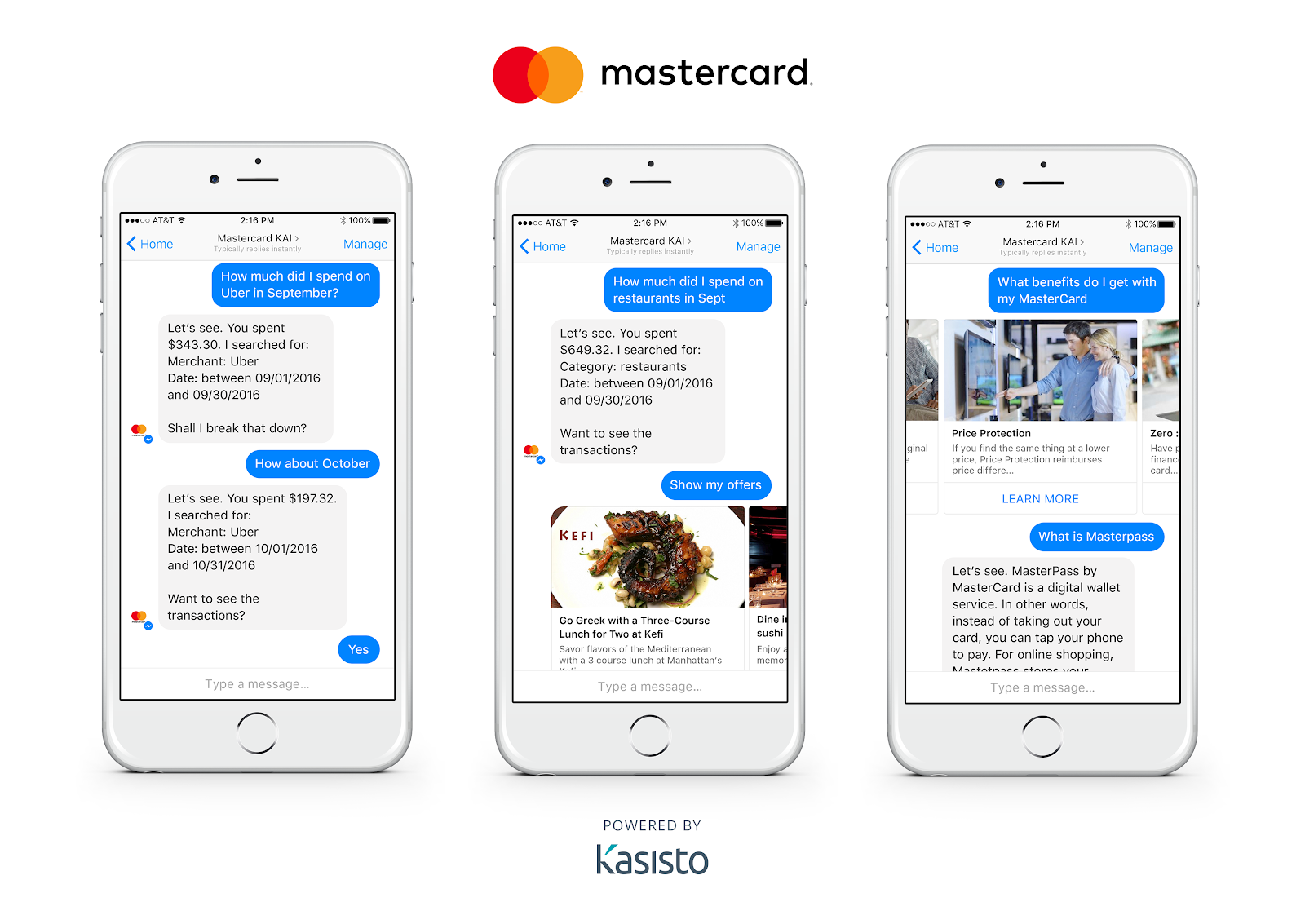Chatbots have come a long way. They’ve gone from greeting customers and answering queries to helping businesses increase their sales by 67% and save as much as 30% on customer support costs.
Customers are more demanding than ever, and to keep up, chatbots have gotten smarter.
With all the advancements in technology, chatbots have so much to offer. For many businesses, they can play a critical role in increasing conversions—when utilized to their full advantage.
Don’t leave any conversions on the table.
Get the inside scoop on how you can use chatbots to get more conversion, learn how the heck they work (from the simple to the complex), and the best practices to follow. We’ll also give you an idea of practical use-cases and examples to help you understand how to use one for your own business.
- What are chatbots?
- 4 benefits of chatbots (with examples)
- Website chatbots
- Chatbots on messaging platforms and social media
- 3 types of chatbots
- Common simple chatbot use cases and examples
- Common smart chatbot use cases and examples
- Hybrid chatbots use cases and examples
- Results from chatbots
- 6 chatbot best practices to implement right away
- Ending the chat
Get brand new conversion strategies straight to your inbox every week. 23,739 people already are!
What are chatbots?
A chatbot is a software, powered by rules and sometimes artificial intelligence (AI), that simulates conversations and allows humans to interact with software as if it were a real person. Chatbots can be as simple as a bot that answers basic questions or as complex as virtual assistants. They are often used with messaging apps, websites, within apps, or even on phones.
Suppose you want expert help to optimize your current marketing plans, and you visit KlientBoost's website (good choice, btw 😉). You'll find a chatbot located on the lower right-hand side of your screen to help you navigate our site.
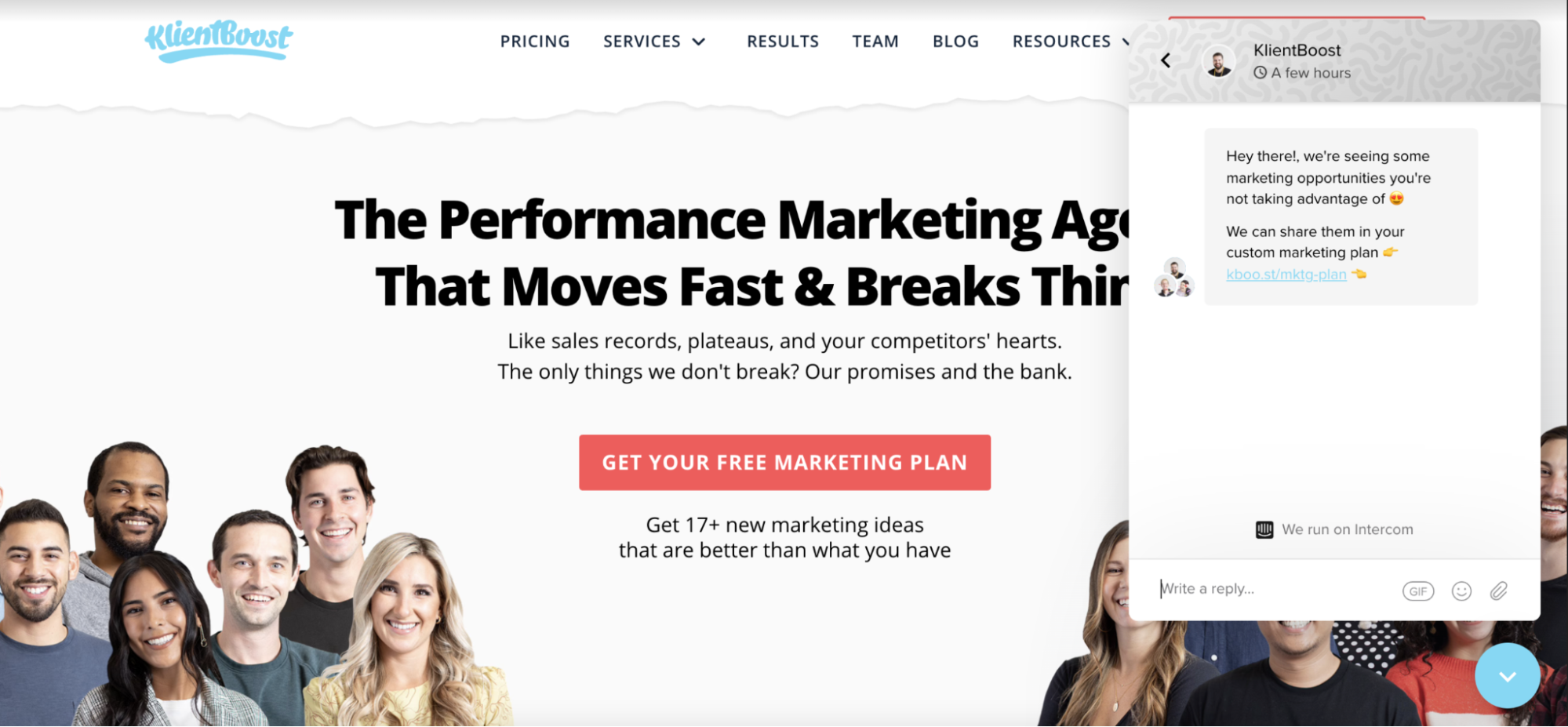
Notice how the KlientBoost bot also offers useful links to help you in your search.
This mirrors the type of experience you would get when you go into the retail store without the pain and hassle of actually going to the store location.
Similarly, if you want to boost your conversions, you can build a conversionbot for your website, which is a form of a chatbot made specifically for conversions.
4 benefits of chatbots (with examples)
Chatbots are taking over—and with good reason.
And by taking over, we mean absolutely ruling the digital landscape.
For the first time ever people are using messenger apps more than they’re using social networks.

When you consider the positive impact a chatbot can have on a business, its quick rate of adoption is a no-brainer.
Chatbots can
- help nudge and nurture potential customers
- be an efficient solution that helps save time and money
- offer a wealth of personalization opportunities
- provide customer service and great user experience
Let’s dig into that more.
Help nudge and nurture potential customers for more conversions
Chatbots help businesses take customer engagement to the next level. One of the ways chatbots engage visitors is by immediately being able to answer any qualms or concerns that a visitor has, like Peloton.
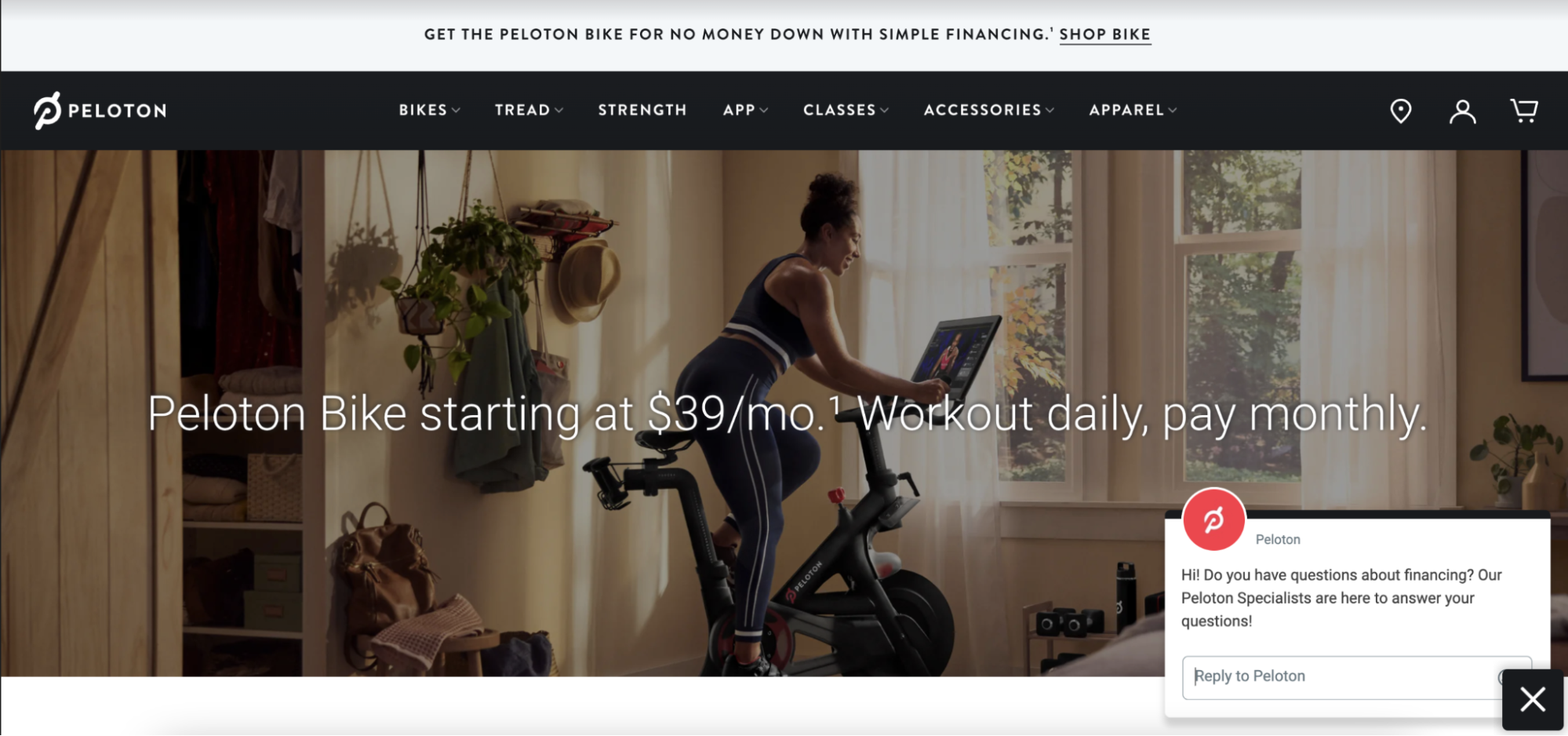
Unlike humans, chatbots don’t sleep. Whenever your customer needs assistance, your company is there even outside of business hours.
From providing additional information on products and shipping to solving product-specific problems, chatbots can start one-on-one conversations immediately, enhancing their experience with your brand.
Chatbots are also great for CRO because humans actually open up more when they know they're talking to a bot.
Alison Darcy, Woebot's CEO and founder, says that chatbots create a more accessible and available space for mental health tools:
"We know that, often, the greatest reason why somebody doesn’t to another person is just stigma. When you remove the human, you remove the stigma entirely."
This is why, at KlientBoost, we don’t inform customers upfront that a person will contact them to get their information and share pricing for their offer.
Efficiency that saves time and money
Chatbots can feel like an expensive investment at first, especially if you're a small business owner, but the numbers suggest otherwise.
A study by Retail Dive found the return on investment (ROI) on chatbots is worth the investment. Case in point: Chatbots can save over $11 billion and nearly 2.5 billion hours for the banking, healthcare, and retail business sectors by 2023.
This makes sense considering what chatbots can do for your business, including:
- Reducing people-to-people interaction time across all channels
- Automating time-consuming, manual tasks
- Delivering fast, real-time responses to avoid losing customers to your competitors
... and more!
Twilio's chatbot offers visitors a slew of suggestions, making the communication faster and more direct. All the visitor has to do is choose the suitable option and the chatbot will help them right away.
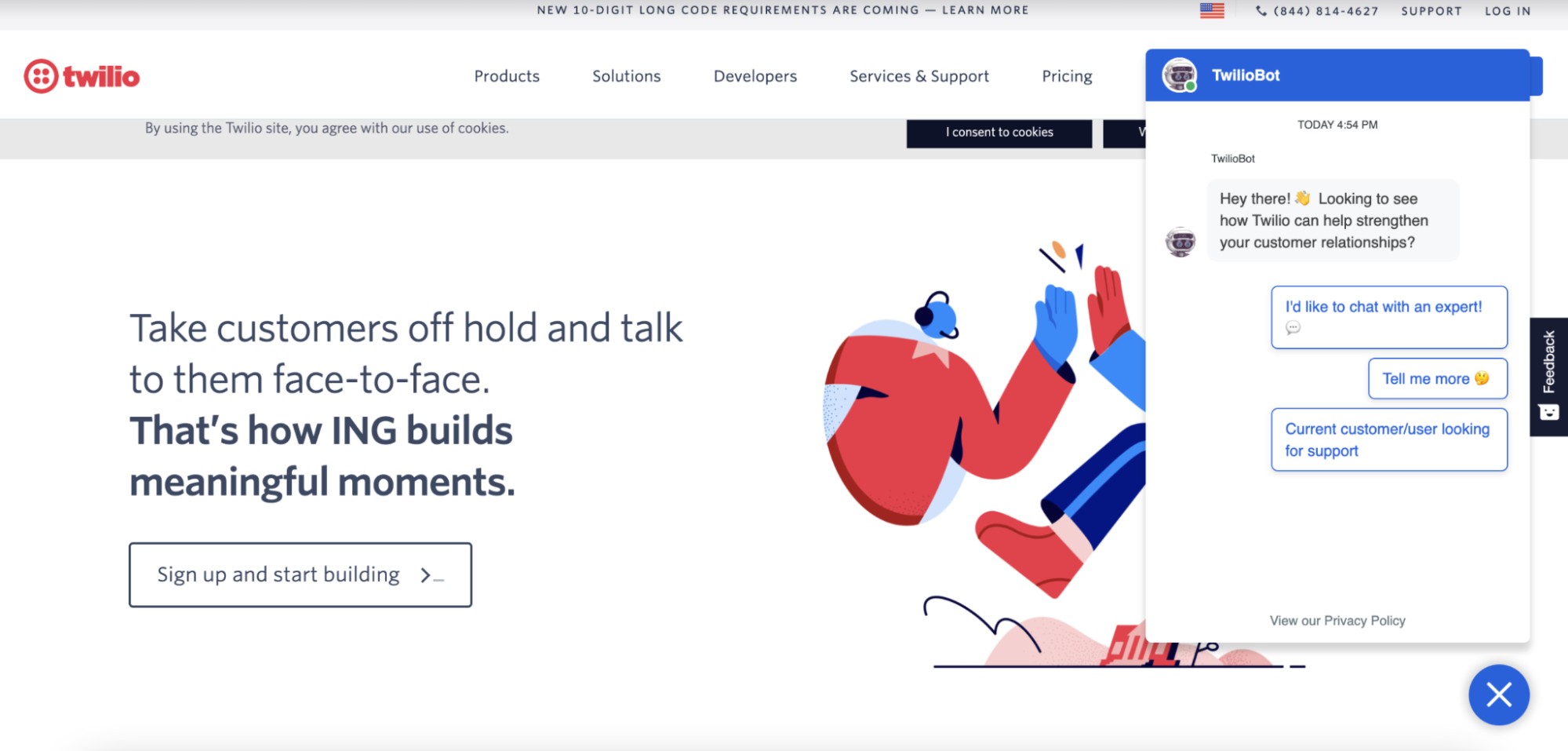
Personalization
Email marketing expert Dan Jak famously said, “Personalization isn’t about first/last name. It’s about relevant content."
Chatbots deliver personalized customer experiences that can make your brand stand out from the competition. By collecting valuable customer data on consumer behaviors, interests, and purchasing habits, Chatbots can leverage the information to start engaging, one-on-one conversations with customers.
Some even take personalization to another level, like this one from ConvertFlow.

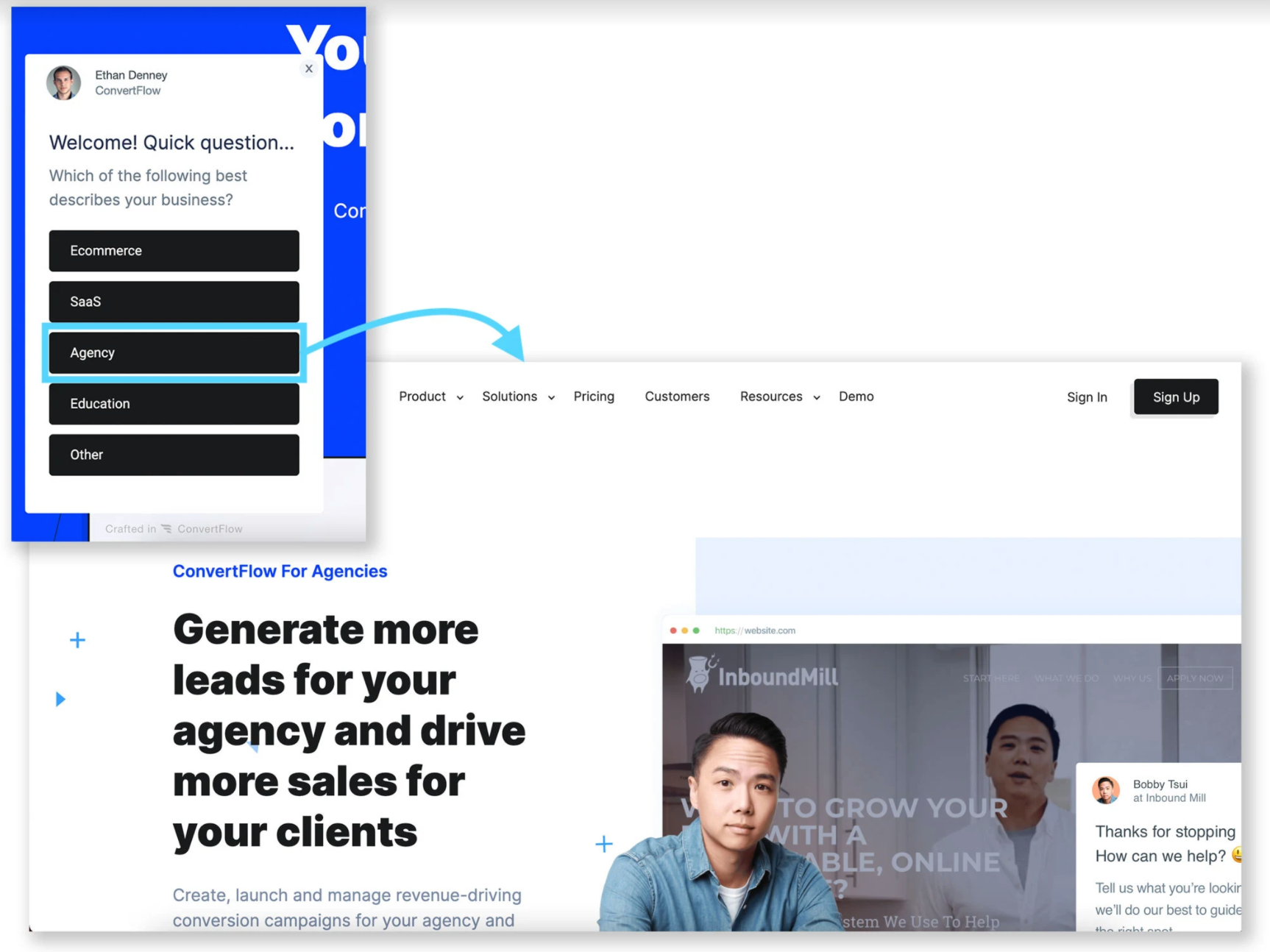
ConvertFlow‘s chatbot asks visitors to describe their business, and based on their answers, directs them to the appropriate landing page. It’s in the best interest of both ConvertFlow and the visitor. The visitor now gets relevant information handed right to them, and ConvertFlow has a better chance of showing their value.
Customer service and great user experience
Chatbots have truly revolutionized customer engagement, which is great because engaged customers represent a 23% higher share in profitability, revenue, and relationship growth.
Conversational AI chatbots, for one, leverage user data to make customer interaction more interactive and personalized. An excellent example of this would be making online reservations. As soon as a visitor shows interest in booking, the chatbot will immediately direct them to the booking page in an attempt to close the sale.
Better yet, chatbots can act as part of your customer service team. Rather than needing a rep to handle problems, a chatbot can answer user questions quickly and efficiently. And when the problem is too complex for a chatbot, you can seamlessly transition to a real person. That’s what Dick’s Sporting Goods does:
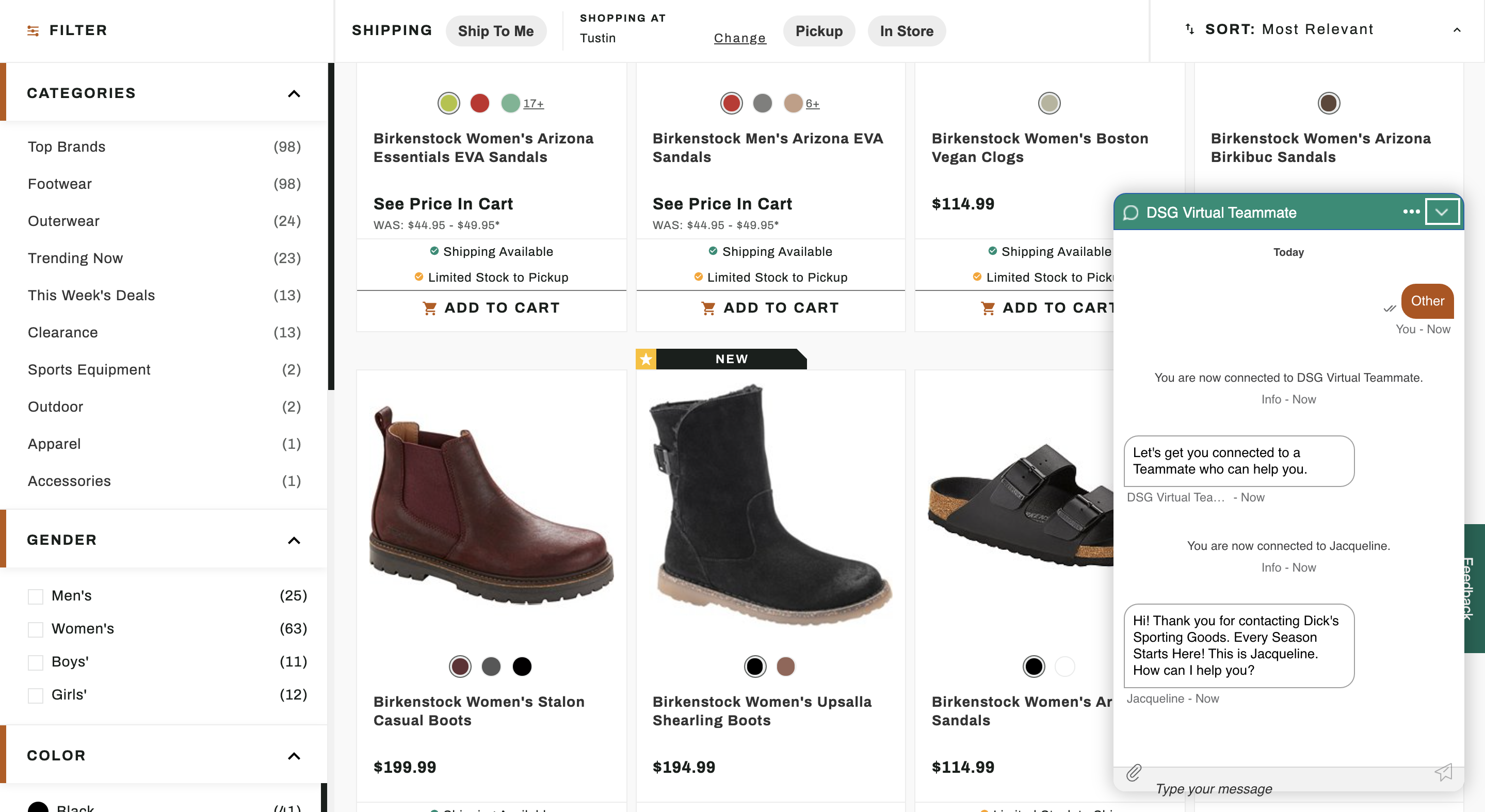
This kind of quick and hassle-free experience ensures greater customer satisfaction and promotes self-service.
Website chatbots
Website chatbots only exist on a website and not on any other third-party platforms. They can interpret and process user phrases to give an instant pre-set answer. These are mainly used for providing streamlined customer service.
Your website visitors can use these bots to navigate the site, learn more about your product line, or ask for additional support. Mailchimp, for example, can process short phrases to help its visitors with anything they want.
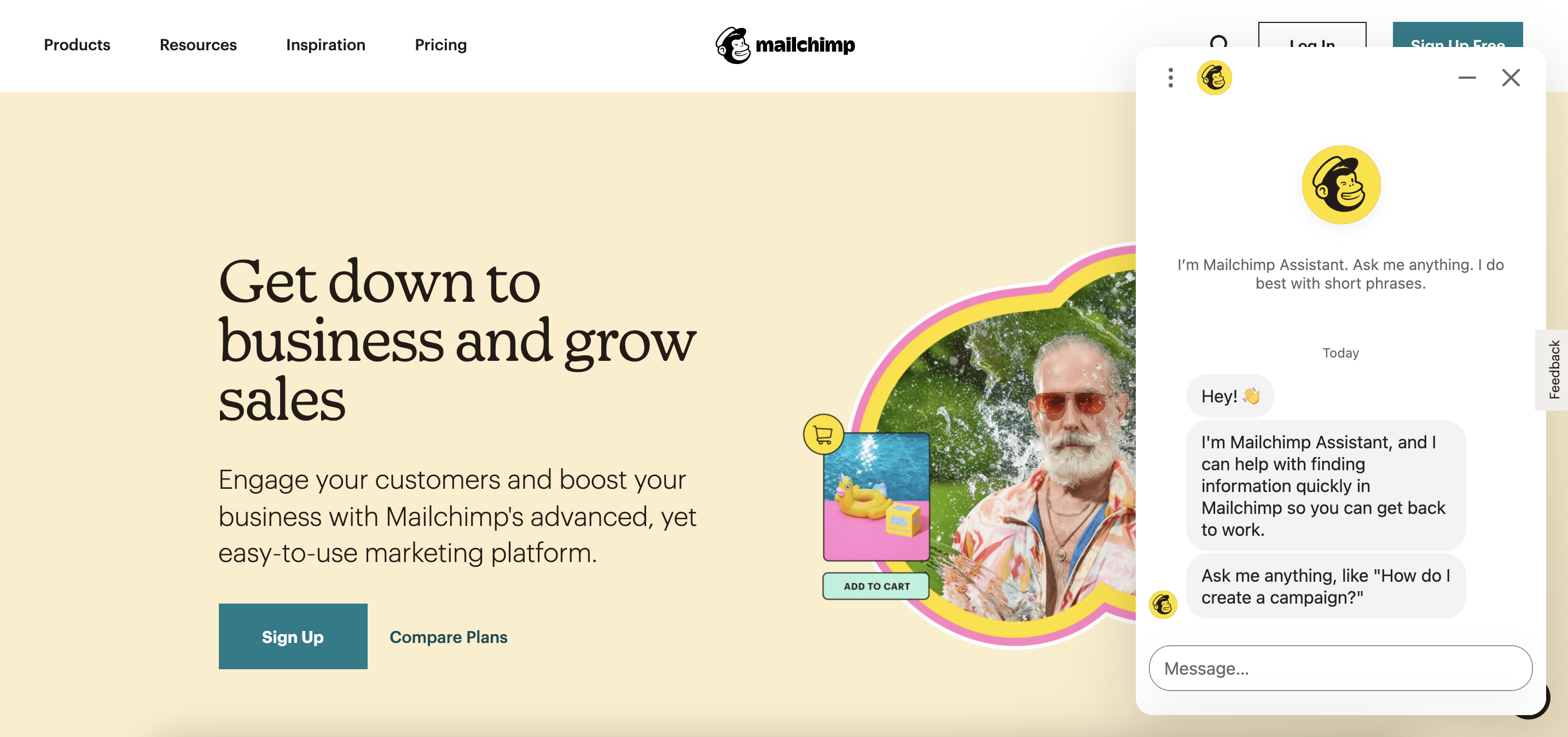
Chatbots on messaging platforms and social media
Bigshots like Google and Facebook have already developed their messaging apps into chatbot platforms to handle services like orders, payments, and bookings.
With the ever-increasing growth of apps like WhatsApp and Skype, demand for virtual chatbots that can automate simple conversations and solve user problems will also increase.
Clearly, installing chatbots on messaging platforms and social media is a good idea. They provide users faster access to information when compared to service agents. Take this Joybird chatbot, for example.
I had engaged with a brand awareness ad from Joybird on Facebook. One day later, they slid into my DMs:

It’s a brilliant use of a chatbot that shows how you can use it to nudge customers along the funnel, even on social.
But if you need more motivation to build a chatbot, it’s the fact that they can facilitate tons of automated response options, letting you effectively communicate with your customers during specific scenarios and give quick updates concerning their issues.
Check out how HubSpot and Sprout Social have automated their customer service through Twitter chatbots.

Further reading: How To Use Facebook Messenger Chatbot For More Conversions
3 types of chatbots
Here are the three main types of chatbots based on their technical complexity:
- Simple chatbots have limited capabilities and a task-specific approach. They interpret questions based on predetermined options that customers can choose from until they get a suitable answer for their query.
- Smart chatbots are-AI enabled and can stimulate near-human interactions with customers. Not only do they understand intent, sentiment, language, but the bots can also hold free-flowing conversations. However, smart bots are harder to implement and execute as they require a lot of programming to understand the context of interactions.
- Hybrid chatbots are a combination of simple and smart chatbots that meet the middle ground. As they have a few rule-based tasks and can understand intent and context, hybrid chatbots make a balanced tool for businesses to interact with customers.
At the core of chatbot technology is something called natural language processing (NLP) and machine learning. NLP is the same technology behind the voice recognition systems used by virtual assistants such as Apple’s Siri, Microsoft’s Cortana, and Google Now.

Chatbots read and process the user-given text (a process known as “parsing”). Then they craft a response based on a complex series of algorithms that attempt to understand and interpret what the user said and, more importantly, what they mean and/or want. The bot then chooses from a selection of appropriate responses to relay to the user.
Some chatbots offer an uncanny conversational experience, in which it’s challenging to figure out whether the “person” you’re speaking to is a bot or a human being. Others are much easier to spot, like this little guy trying their best…
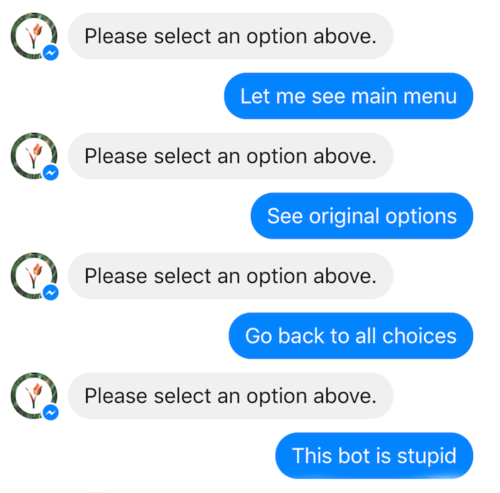
By the way, if you want to see chatbots in action on your landing pages to better understand how they can drive conversions, you can get a custom proposal here.
Common simple chatbot use cases and examples
Depending on how the bot in question is created, we can divide chatbots into two groups: working in accordance with pre-set commands (simple chatbot) and intuitive (smart or advanced chatbot).
Simple chatbots work based on pre-written keywords that they understand. Each of these commands must be written by the developer separately using regular expressions or other forms of string analysis. If the bot can’t understand the user’s input, it responds with messages like “sorry, I didn’t catch that”.
Here are some examples of simple chatbots:
- Weather bot: Get the weather whenever you ask
- News bot: Keeps you updated on current events
- Food bot: Helps you place or track an order
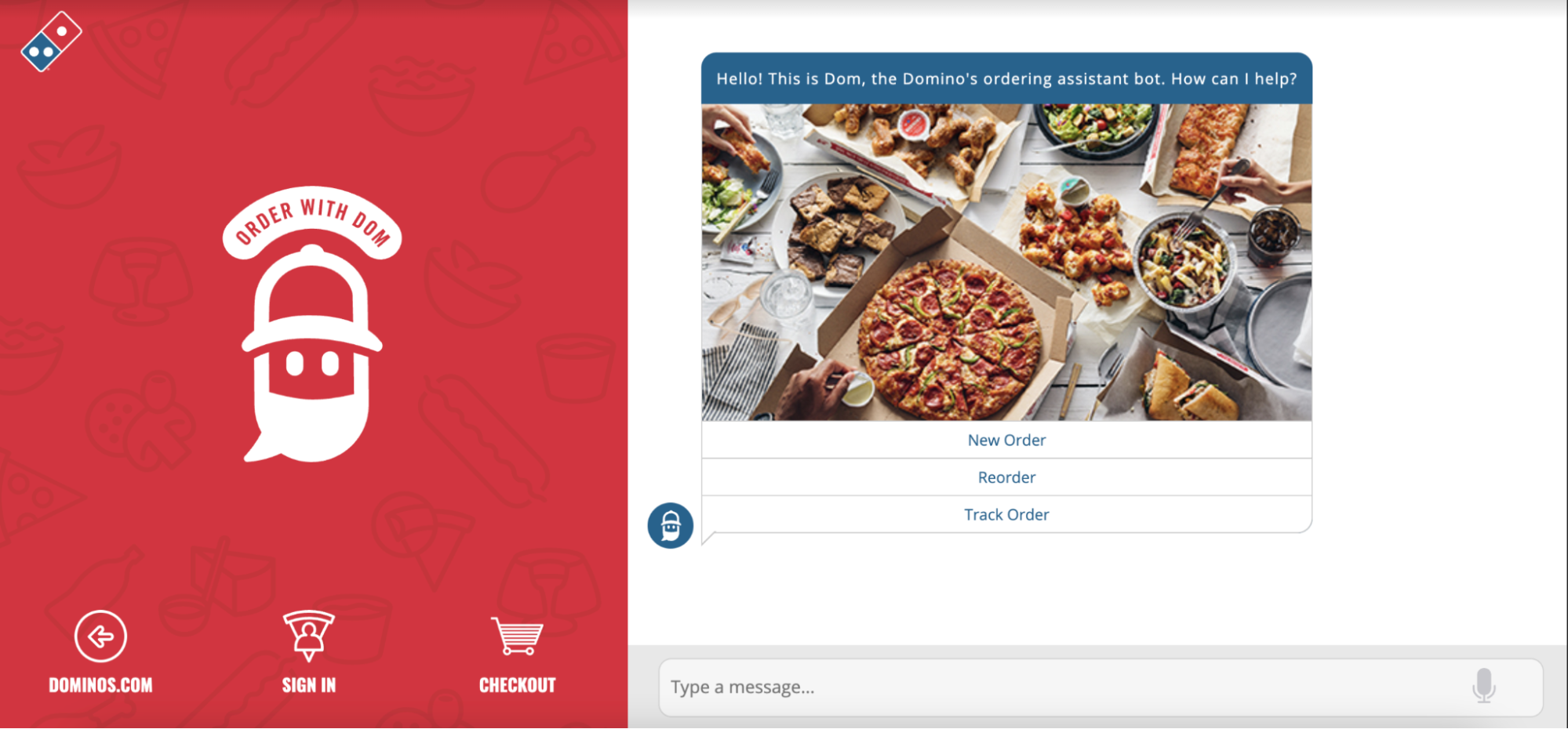
Common smart chatbot use cases and examples
Smart chatbots, in contrast, rely on artificial intelligence when they communicate with users.
Instead of pre-prepared answers, the robot responds with adequate suggestions on the topic. In addition, all customer conversations are recorded for later processing.
However, the Forrester report “The State of Chatbots” points out that artificial intelligence isn't magic, and it’s not ready to produce marvelous experiences for users on its own. On the contrary, it requires lots of work.
Here are a few examples of smart chatbots:
- Life advice bot: I’ll tell it my problems and it helps me think of solutions. MeditateBot helps you stay calm by walking users through meditation exercises
- Legal bot: Such as DoNotPay, which is a free legal assistance bot for people in diverse situations
- Finance bot: Manage your account
- Scheduling bot: A bot that can help set up appointments
- Virtual assistants: Siri, Amazon Alexa, and other voice assistants using text-to-speech and voice recognition APIs, are a modified version of smart chatbots
Hybrid chatbots use cases and examples
Facebook Messenger is one of the most popular mobile messenger apps. Nearly 11% of the global population relies on the app every month. So when it comes to lead generation, Facebook Messenger is a great platform to start with.
Chatbots can be a very valuable solution if you offer a product or service that requires a high level of pre-purchase consideration, such as car sales, real estate, or SaaS.
Financial institution chatbots
Financial institutions that provide individuals or businesses with loans or credit cards are lead-based businesses. They’re always looking for applications.
So how do you get people interested in getting a loan? Offer a loan calculator. After running the calculation in the chatbot, start a conversation and offer a guide in exchange for their email address.
The same tactic can work for the financial planning industry. Advertise a guide on Facebook that would interest potential investors and then take them into the chatbot when they click the ad. From there, you can capture their email address.
Mental health chatbots
Anyone involved in mental health, wellness coaching, or even rehab centers, can benefit from opening up a conversation through a chatbot. Take MossRehab, for example:
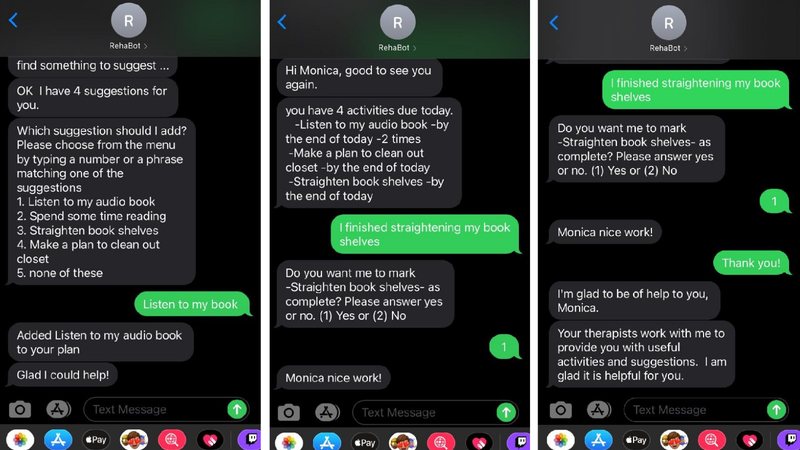
Since the stigma of talking to a real person is gone, it’s possible to warm up your potential customers through a non-threatening conversation with a bot. This can lead to heightened interest in your offer and conversion in the form of sharing their contact information.
Customers may not have been sure before the chatbot conversation, but they’re more confident in their decision afterward.
Real estate chatbots
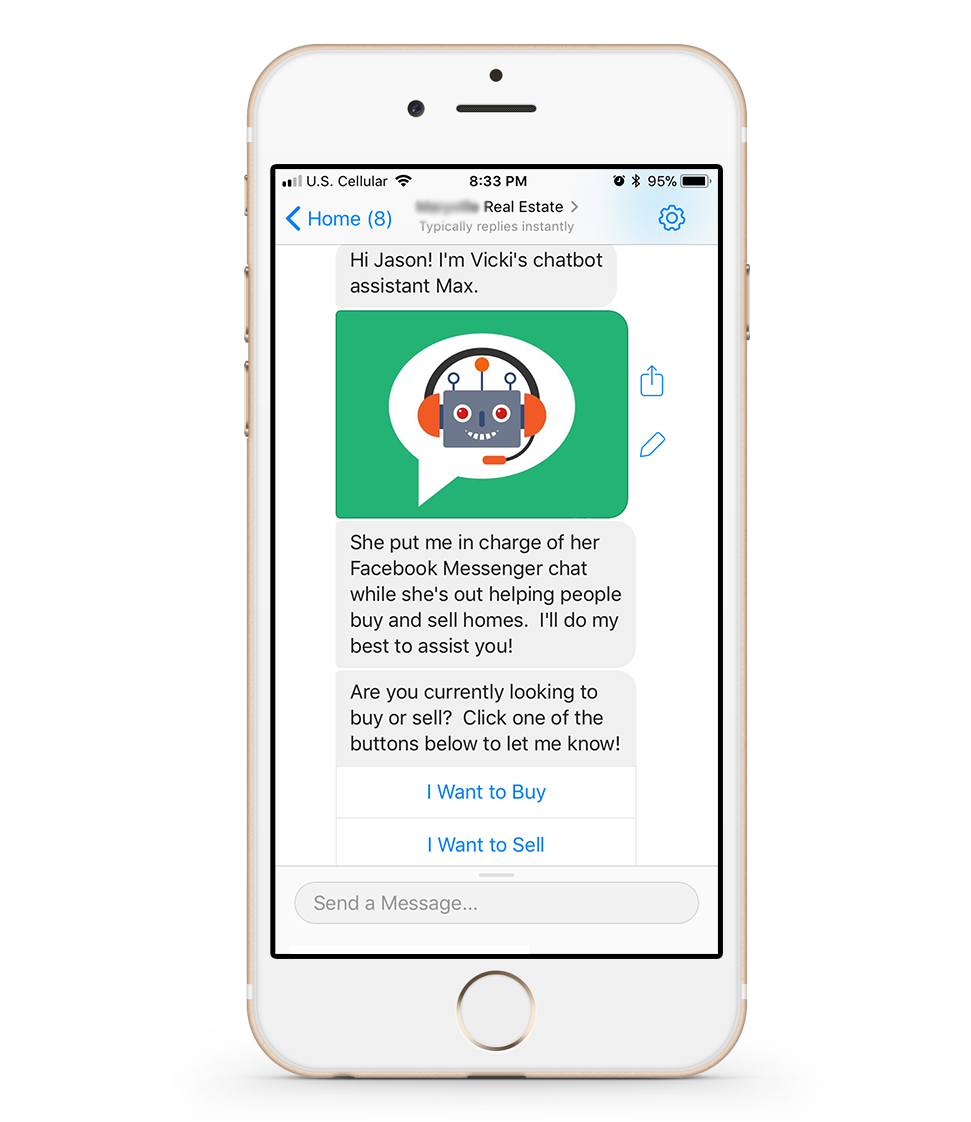
These bots can help with automating quotes and lead-gen for potential customers. Try giving free home improvement advice through a chatbot to potentially turn those top-of-funnel leads into bottom-of-funnel leads.
By giving advice freely, you quell the customers' fears so that they can decide to choose your service over competitors.
Appointment Chatbots
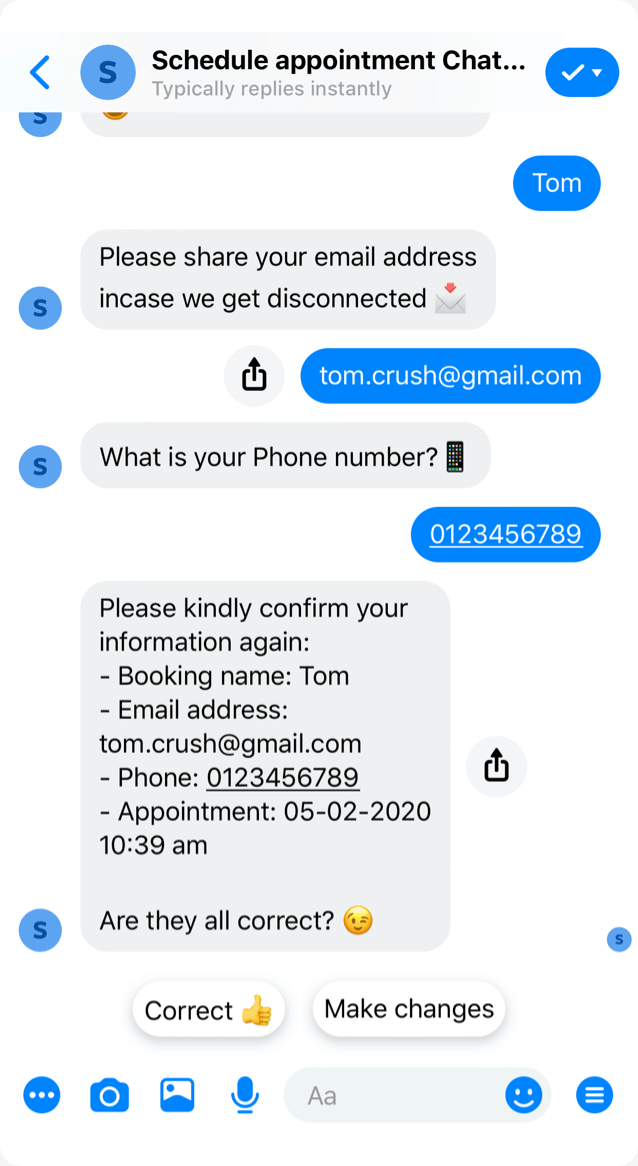
The no-brainer here is appointment-setting bots. If you’re involved in an appointment-heavy industry (hair salons, dental offices, etc.), you can leverage a chatbot as a method for current customers to book spots on your calendar.
Simply contacting your customers via Facebook Messenger will allow you to proactively reach out to them to see how they’re doing, solicit reviews/feedback, and run “refer a friend” promotions.
Results from chatbots
What’s the point of all this if we can’t back it up with data and results, right?
Let's take a look at a few businesses that benefited from implementing/optimizing their chatbots.
- Vista College saw a staggering 292% increase in conversion rates by reinventing its online chat system. After they hired us, we carefully studied prospective students’ biggest objections (time to graduate, pricing, online/offline options), and used the information to simplify and streamline logic chat flows.
- Fast Twitch successfully reduced cost per conversion by 27% and increased their overall lead conversion volume by 52% by using targeted chat greeters, along with sports-specific keyword research and breadcrumb technique landing pages.
- Equity Trust Company split tested their chatbots to deliver faster and more efficient customer support, which, along with other variables, helped the company lower their CPA by 23% and increase their CTR by 246%.
6 chatbot best practices to implement right away
It’s important to understand how your bot interacts with your customers. Whether you code the bot yourself or use a template, here are some key tips that will help you keep your user’s experience top of mind.
1. Don’t lie to your users
People aren’t dumb. If you over-promise or tell them your bot is something that it’s not, they’ll figure it out eventually.
You want your bot experience to feel like a human conversation, but you can’t dress up a dog like a horse and expect it to function the same way. People will get suspicious and it’s a lot harder to close a deal with someone that doesn’t trust you or the validity of your services.
Be upfront and let people know they’re talking to a bot. People are more forgiving when you set clear expectations from the get-go.
Finally, let your customers know the capabilities and limitations of your bot, so they don’t try to use your bot for anything and everything.
2. Ease into the conversation
A few button clicks can help them close in on their objective before providing a typed response.
This path moves users forward in the system, building trust before asking them to engage in conversation. Making all buttons and commands actionable effectively guides your customers into a more natural, written exchange.
3. Design for human emotion
We’re used to robots being bland and boring. Not any more.
Adding touches of personality to your chatbot can boost user engagement and make your bot more fun. Use friendly, inclusive language to make users feel like they’re chatting with a colleague.
Also, don't be afraid to repeat inputs back to users to check for understanding. This garners trust with your users and can help increase repeat business.
4. Have a Plan B for when the bot (inevitably) breaks
If you can build it, it can break. Unless your bot is completely templated and operates solely through button clicks, your bot is going to break at some point or another.
It’s important to come to terms with this and come up with a plan B. Show that you understand the customer’s pain and offer solutions on how to handle the situation and reroute users to safe areas within your system.
And whatever you do, do NOT leave a blank empty space on your bot. Incorporate an error message to alert users that something is not right, so they don’t sit there waiting and hoping for something to load.
Lastly, when the machines stop working, who do we talk to? We want to talk to the person in charge. Offer human intervention when things go awry to instill that trust in your customers.
5. Detect frustration, and ensure handoff to an agent
Regardless of how well designed your chatbot is, it'll have its limitations—limitations that can lead to frustrations.
To make sure you don't lose your customers to your competitors, you should have a system to detect user emotion by analyzing their language and tone. A good example response can be: “I seem to have trouble helping you. Would you like to talk to our live agent?”
6. Help users help you
You can never predict everything your customers want. Luckily, modern functionality can empower your users to give feedback directly through the bot.
You can, for example, let users submit articles when they ask for something your bot doesn’t have the answer to. And you can ask users if the results your bot gave them are what they were looking for. If they aren’t, let users tell you what they want and follow up if you find particularly insightful feedback.
Ending the chat
There you have it.
Chatbots can be your secret weapon for more conversions. Be sure to use them correctly to squeeze the most value out of it.
Make sure your chatbot is installed on your website and even your social channels.
If it’s set to utilize customer data and turn it into a perfectly curated, personalized experience, your results will soar higher than you can imagine. Don’t stop there though. Provide the best logic to your chatbot so that it’s able to answer the most common questions visitors have, reducing friction and opening that pipeline right up.
Chatbots are about to be your new best friend.
Curious what other tools can help turn up your conversion rates? Good, cause there are tons.
